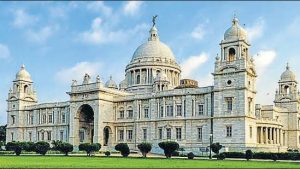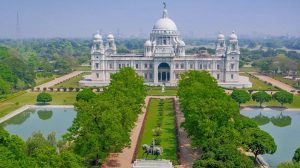Digital News Guru West Bengal Desk:
The Victoria Memorial: A Testament to Colonial Grandeur and Indian Heritage
The Victoria Memorial, located in the heart of Kolkata, West Bengal, is one of the most iconic landmarks of India. Constructed in honor of Queen Victoria, this grand edifice is an exquisite blend of British and Mughal architecture. Today, it stands as a symbol of India’s colonial history and its transition into a modern nation, serving as a museum and a popular tourist attraction. This article delves into the history, architecture, cultural significance, and legacy of the Victoria Memorial.
Historical Context
The Victoria Memorial was commissioned in 1901 by Lord Curzon, the then Viceroy of India, shortly after the death of Queen Victoria. The idea behind this grand structure was to commemorate the life and reign of the queen, who had been the Empress of India since 1876. Curzon envisioned the memorial as a fitting tribute to her legacy and a symbol of the British Empire’s dominance in India.

The construction of the memorial began in 1906 and was completed in 1921. Funded by contributions from British officials, Indian princes, and the public, the Victoria Memorial was inaugurated by the Prince of Wales, who later became King Edward VIII. While the memorial was built during the colonial era, it has since become an integral part of India’s cultural landscape.
Architectural Brilliance
Designed by Sir William Emerson, the Victoria Memorial is an outstanding example of Indo-Saracenic architecture, a style that combines elements of British, Mughal, and Venetian designs. The structure is predominantly made of white Makrana marble, sourced from Rajasthan, giving it a striking and timeless appearance. The architectural style is further enhanced by intricate detailing, domes, columns, and statues.
The central dome of the Victoria Memorial is its most distinctive feature, crowned by a 16-foot tall bronze statue of the Angel of Victory. The statue, mounted on ball bearings, rotates with the wind, symbolizing triumph and progress. Surrounding the central dome are smaller domes and cupolas, adding to the building’s grandeur.
The memorial is spread over 64 acres of lush gardens, designed by Lord Redesdale and Sir David Prain. These meticulously maintained gardens feature water bodies, fountains, and a variety of seasonal flowers, creating a serene environment that complements the grandeur of the marble structure. The gardens also house several statues and memorials, including those of Queen Victoria, Lord Curzon, and other historical figures.

The Museum and Its Collections
The Victoria Memorial is not just an architectural marvel but also a repository of history and culture. It houses a museum that showcases a vast collection of artifacts, paintings, manuscripts, and memorabilia from the colonial period. These exhibits provide a glimpse into the life and times of Queen Victoria and the British era in India.
Among the museum’s highlights are:
- Portrait Gallery: This gallery features portraits of British royalty, including a life-size painting of Queen Victoria, created by renowned artists of the time.
- Historical Artifacts: The collection includes a variety of items such as Queen Victoria’s personal belongings, weapons, and uniforms from the British period.
- Indian Art and History: The museum also displays artifacts related to India’s rich cultural heritage, including Mughal miniatures, manuscripts, and sculptures.
- Calcutta Gallery: This section focuses on the history and evolution of Kolkata, showcasing maps, photographs, and documents that trace the city’s transformation from a colonial capital to a modern metropolis.
- Royal Paintings: The museum is home to exquisite oil paintings, watercolors, and sketches that capture significant events from the Victorian era.
Cultural Significance
While the Victoria Memorial was originally built as a tribute to the British monarchy, it has since taken on a new identity as a symbol of Kolkata’s cultural and historical heritage. It attracts millions of visitors every year, including tourists, history enthusiasts, and locals who come to admire its beauty and explore its rich collections.
The memorial is also a hub for cultural events, including exhibitions, music concerts, and literary festivals. These events highlight the city’s vibrant cultural scene while adding a contemporary dimension to the memorial’s historical significance. During festivals like Christmas and New Year, the Victoria Memorial and its gardens are beautifully illuminated, creating a magical ambiance that draws large crowds.
Symbolism and Legacy
The Victoria Memorial is more than just a monument; it represents a complex interplay of colonial history and post-independence identity. For the British, it was a symbol of imperial pride and dominance, showcasing their architectural and administrative prowess. For Indians, especially post-independence, the memorial has become a reminder of a tumultuous period in history and a space to reflect on the nation’s progress and resilience.

The memorial’s design also reflects the blending of cultures that characterized colonial India. The fusion of British and Indian architectural elements symbolizes the interconnected histories of the two nations. Today, the Victoria Memorial serves as a bridge between the past and the present, encouraging dialogue about colonialism, nationalism, and cultural exchange.
Conservation Efforts
Over the years, efforts have been made to preserve the Victoria Memorial and its surroundings. The Indian government, along with various cultural and heritage organizations, has undertaken initiatives to maintain the structure, its museum collections, and the gardens. Advanced techniques are used to clean and restore the marble façade, ensuring that the memorial retains its pristine appearance.
Modern facilities, such as guided tours and interactive displays, have been introduced to enhance the visitor experience. The museum has also digitized parts of its collection, making it accessible to a global audience and promoting the memorial as an educational and cultural institution.
The Victoria Memorial Today
Today, the Victoria Memorial stands as one of Kolkata’s most cherished landmarks and a symbol of the city’s cosmopolitan spirit. It is a popular tourist destination, offering visitors a unique blend of history, art, and architecture. Whether it is the awe-inspiring structure, the tranquil gardens, or the rich museum collections, the memorial offers something for everyone.
Beyond its role as a tourist attraction, the Victoria Memorial continues to inspire discussions about heritage conservation, colonial history, and the evolution of Indian identity. It is a reminder of the city’s colonial past and its vibrant present, making it an enduring symbol of change and continuity.
Conclusion
The Victoria Memorial is a timeless masterpiece that encapsulates the grandeur of British India and the cultural richness of Kolkata. Its stunning architecture, historical significance, and cultural role make it a must-visit destination for anyone exploring the city. As it stands tall amidst the bustling streets of Kolkata, the Victoria Memorial remains a bridge between the colonial past and the independent, dynamic present, embodying both the complexities and the beauty of India’s heritage.
You May Also Read: Masterpieces of the Chola Dynasty: The Magnificent Brihadeshwara Temple








